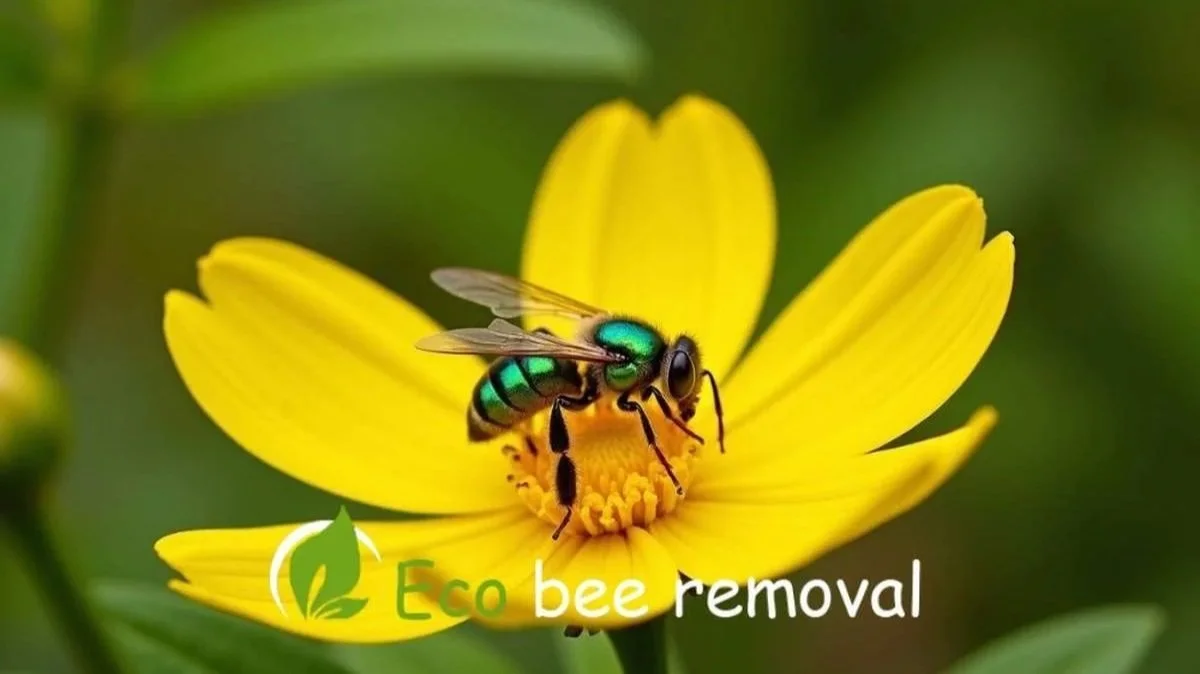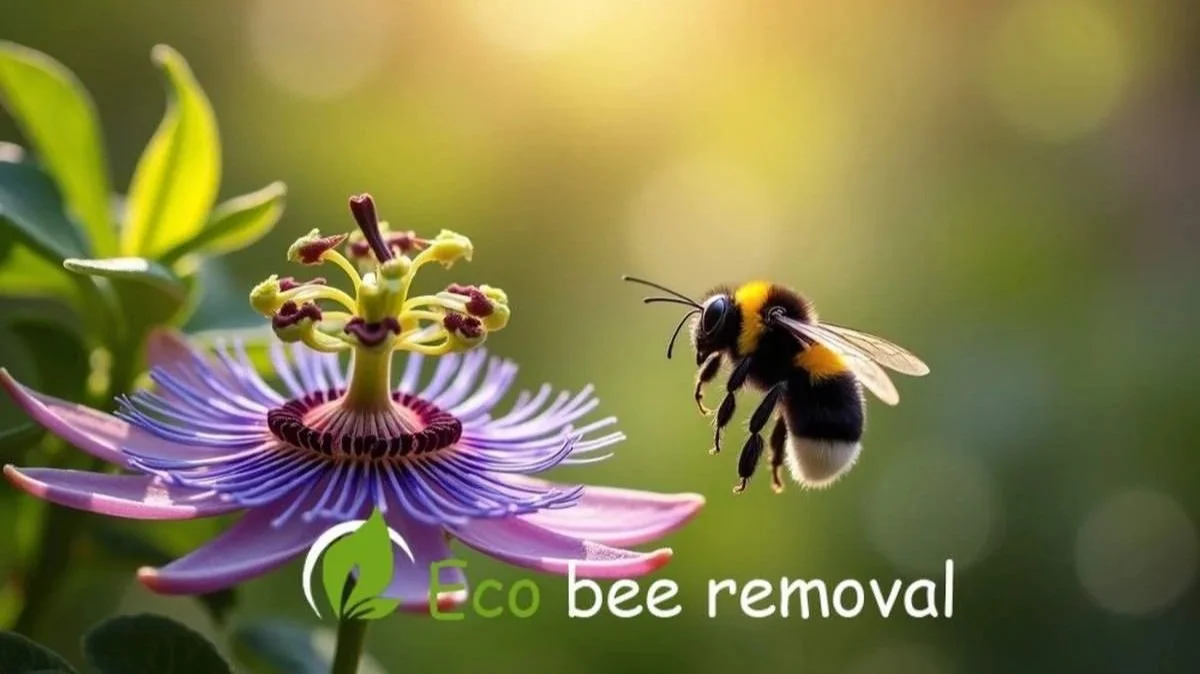Florida’s Native Bee Species and How to Protect Them.
Understanding and Preserving the Pollinators That Keep Florida Blooming
Metallic green sweat bee resting on a yellow Florida tickseed flower.
Florida is home to some of the most diverse and fascinating bee species in North America. While honey bees often get the spotlight, they’re not actually native to the Sunshine State — or even the U.S. Instead, Florida’s ecosystems thrive thanks to more than 320 species of native bees, each playing a key role in pollinating wild plants, fruits, vegetables, and ornamental landscapes.
Unfortunately, many of these native bees are under pressure from habitat loss, pesticides, climate change, and competition with non-native species. As an eco-friendly bee removal and relocation company, Eco Bee Removal believes education is the first step toward protection.
This guide explains Florida’s native bees, why they matter, signs they may be nesting around your property, and what you can do to help protect them.
Why Florida’s Native Bees Matter
Native bees are the backbone of Florida’s natural environment. They have evolved alongside local plants for thousands of years, creating a powerful partnership.
1. Florida’s Native Bees Are Super-Efficient Pollinators
Unlike honey bees, many native bees are solitary and focus intensely on specific plants. This makes them extremely effective at pollinating crops such as:
Watermelons
Blueberries
Tomatoes
Cucumbers
Squash and pumpkins
Wildflowers and native shrubs
Some research shows that a single blue orchard bee can pollinate as effectively as 100 honey bees. That gives Florida’s native species an irreplaceable role in local agriculture.
2. They Support Biodiversity and Healthy Habitats
Native bees keep Florida’s ecosystems balanced by pollinating the plants that feed birds, mammals, butterflies, and other wildlife. Without them, entire natural food chains would collapse.
3. They Are Better Adapted to Florida’s Climate
Florida’s unique humidity, storms, heat, and tropical plants require pollinators that can handle extreme conditions. Native bees are perfectly suited to this environment, while non-native species struggle more.
Common Native Bee Species in Florida
Florida’s native bees come in many shapes, colors, and sizes. Here are some of the most common and important species homeowners may notice.
1. Bumble Bees (Genus: Bombus)
Large, fuzzy, and gentle, bumble bees are excellent pollinators of tomatoes, berries, peppers, and native plants.
How to identify:
Round, fluffy bodies
Black and yellow or black and orange patterns
Slow, loud “buzz pollination” vibration
Nesting habits:
They often build nests in:
Abandoned rodent tunnels
Under sheds
Ground cavities
Brush piles
Bumble bees rarely cause damage and are crucial for Florida's crops.
2. Carpenter Bees (Genus: Xylocopa)
Often mistaken for bumble bees, carpenter bees are shiny with less hair.
How to identify:
Large black bodies with a metallic sheen
Hovering at doorways or wooden structures
Males may “guard” but cannot sting
Nesting habits:
They drill into untreated or weathered wood, but the damage is usually minor unless activity is ignored for years.
Carpenter bees are incredible pollinators for flowering trees like citrus, hibiscus, and passion vines.
3. Sweat Bees (Family: Halictidae)
These tiny bees are abundant in Florida lawns and gardens.
How to identify:
Small, metallic green or blue bodies
Harmless and shy
Attracted to human sweat (salt)
Nesting habits:
They create burrows in sandy soil and help pollinate wildflowers and edible plants.
4. Leafcutter Bees (Genus: Megachile)
These bees are essential for vegetable gardens and wildflower patches.
How to identify:
Carry pollen under the abdomen, not on their legs
Cut neat circles in leaves for nesting material
Not aggressive
Nesting habits:
They nest in hollow stems, cracks, wood holes, and bee houses.
5. Blue Orchard Bees (Genus: Osmia)
A favorite among Florida growers because of their efficiency.
How to identify:
Metallic blue/green bodies
Solitary, calm, and non-aggressive
Nesting habits:
Use holes in wood, reeds, bamboo, and bee houses.
Bumble bee hovering near a passionflower vine in a Florida garden.
Threats Facing Florida’s Native Bees
Native bees are disappearing faster than most people realize. Here are the biggest dangers:
1. Habitat Loss
Urban development has destroyed natural nesting areas such as:
Dead trees
Sandy soil
Wildflower habitats
Undisturbed land
Without nesting sites, bee populations shrink.
2. Pesticides
Common lawn and garden chemicals kill native bees instantly or weaken them over time. Neonicotinoids are especially harmful.
3. Climate Change
Heatwaves, hurricanes, and irregular blooming seasons make it harder for native bees to feed and reproduce.
4. Competition With Non-Native Bees
Honey bees and invasive species compete for food and nesting areas, stressing native populations.
How to Protect Florida’s Native Bees
Even small changes can make a huge difference. Here are meaningful steps Florida homeowners can take:
1. Plant a Bee-Friendly Garden
Use native plants that offer nectar and pollen. Some excellent Florida options include:
Firebush
Black-eyed Susan
Blanketflower
Tickseed (Florida’s state wildflower)
Milkweed
Goldenrod
Saw palmetto
Passionflower
Planting in clusters helps bees find food easily.
2. Avoid Pesticides
If possible, stop using:
Neonicotinoids
Herbicides
Broad-spectrum insect killers
If you must treat pests, choose natural alternatives like neem oil or insecticidal soaps — and apply them at night when bees aren’t active.
3. Provide Nesting Habitat
Different species need different homes. You can help by:
✔ Leaving some bare, sandy soil patches
✔ Keeping dead logs or branches in wooded areas
✔ Installing bee hotels for leafcutter and mason bees
✔ Allowing natural brush piles in your yard
4. Give Bees Access to Water
A shallow bee bath helps native bees survive Florida’s intense heat.
Use:
A shallow dish
Pebbles or marbles
Fresh water
Bees need places to stand while drinking.
5. Choose Eco-Friendly Bee Removal
If bees are nesting in your wall, attic, or roof, don’t kill them. Native bees are protected pollinators and should be relocated safely.
Eco Bee Removal provides:
Live bee relocation
Safe nest removal
Eco-friendly solutions
Repairs to prevent future infestations
You save the bees — and your home.
6. Support Florida Conservation Programs
Local organizations play a crucial role in protecting native bees and their habitats. Consider supporting:
Florida Native Plant Society
University of Florida IFAS bee research programs
Local pollinator gardens
Neighborhood conservation groups
Signs Native Bees May Be Nesting Near Your Home
Native bees are usually harmless, but you may notice:
Bees are entering small holes in walls or soffits
Round holes drilled in wood
Bees flying low over sandy soil
Leaf circles cut from plants
A steady “buzz” from a shed or ground cavity
If the activity becomes concerning, always opt for live relocation over extermination.
Final Thoughts
Florida’s native bees are essential pollinators that support agriculture, wildlife, and home gardens. Protecting them is not only good for nature—it’s good for future generations and Florida’s environment as a whole.
By planting native flowers, avoiding pesticides, supporting conservation programs, and choosing eco-friendly removal services, you play a direct role in saving Florida’s bees.
If you discover bees on your property, Eco Bee Removal is here to help with safe, humane, and sustainable bee relocation across Florida.


